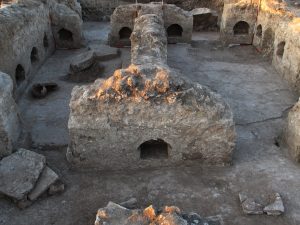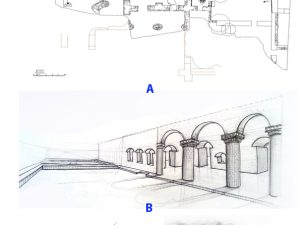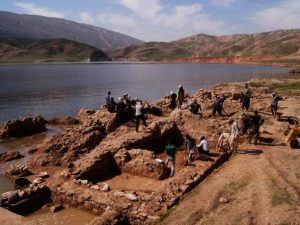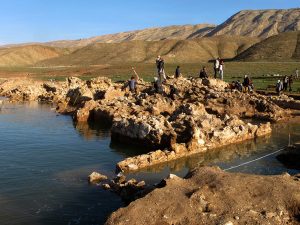Ramāvand/Qalā Gūriرماوند/قلاگوری
Location: Qalā Gūri or Qal’eh Gūri is in Luristan, western Iran, Luristan Province
33°20’34.61″N 47° 8’48.51″E
Map
Historical Period
Sasanian
History and description
Qalā Gūri or Qal’eh Gūri is in the vicinity of the abandoned/submerged village of Ramāvand, on the north bank of the Seymareh River, in the Konani district near Kuhdasht, in Luristan. The locality known as Qalā Gūri was, in fact, part of a larger late Sasanian site built on the slope of the hills near the Seymareh River. The excavated remains consist of structures in rubble masonry (fig. 1). Two roofed buildings with an arcaded portico that opens onto a courtyard (fig. 2). The surviving area of the portico measures 900 x 390 cm with two columns decorated with stuccoes depicting geometric and floral motifs. The structures were submerged and destroyed when the area behind the Seymareh Dam was flooded in 2011.
Archaeological Exploration
In 1936, Sir Aurel Stein visited and explored the region around Kuhdahst, but he did not cover the area between Kuhdasht and the Seymareh River. He even refers to a Qalā Gūri (Qal’ai-i-gauri, the "Fort of the Gabrs") with painted and plain ceramics. But, based on his description, that must be another Qalā Gūri located in the vicinity of Kuhdasht (Stein, Old Routes of Western Iran, p. 258). Had he gone further south to the northern bank of the Seymareh, he would have certainly found the large archaeological site at Ramāvand. The presence of archaeological remains at Ramāvand/Qalā Gūri was first reported in 2007 following the project for building a dam on the Seymareh River at the eastern end of the valley (Borujeni, Gozāresh-e Barresi va shenāsā’i). The Iranian Center for Archaeological Research (ICAR) carried out rescue excavations at Qalā Gūri under the author’s direction in 1389/2010, 1391/2012, and 1392/2013 (for the reports, see the bibliography under Hasanpour). It should be noted that the whole inundation zone behind the Seymareh River Dam was the object of a broader rescue archaeological project led by Lili Niakan on behalf of the ICAR.
The first season of excavations at Qalā Gūri aimed at saving those structures that had been in immediate danger of being inundated. The work was limited to six 5 × 5 trenches. As a result, the archaeological team was able to uncover and record the central part of a relatively large building. At that time the plan was to protect the excavated structures until another season of work. In the absence of allocated funds, the remains were left unprotected for two years until the area behind the dam was temporarily flooded in the spring of 2012. The archaeological site was unfortunately submerged. After a few months, the dam released water and the level of the lake behind it fell to a point that the site of Qalā Gūri partially reemerged. Rescue excavations were soon conducted in the winter of that year. However, most of the walls had washed away leaving only traces of their stone foundation. Thick columns of the main building had also fallen into the lake (figs. 3 and 4). The results were, however, significant in that the team could uncover two roofed structures and a columned hall decorated with stuccoes (Hasanpour and Hasemi, "A Comparative Study of the New Sassanid’s Stuccos from Qela Guri,"). The last season of excavations was in the winter of 2013 which coincided with the final phase of the dam's flooding. In that season, the team concentrated on excavating and recording fourteen architectural units that included courtyards, rooms, and a partially roofed eyvān. Although 600 m² of the site was under excavation, the project was brought to an end due to the rising level of water. The site was entirely submerged for good in the last days of the third season.
The excavation results show that the structures at Qalā Gūri, in close connection with the adjacent, earlier site known as Barz Qawāleh, are part of a large Sasanian/early Islamic manor house built in two construction phases. Only a small part of the northern courtyard and its related corridors and verandas with their adjacent rooms were uncovered. The residential sector located to the south of the courtyard was washed away and submerged during the flooding process behind the dam. Geomorphological surveys of the terrain indicate that the site was subject to repeated flooding of the Seyemareh River and had been abandoned in the past, possibly in the early Islamic period (Hasanpour, Kāvosh-e nejātbakhshiy-e mohavatey-e Qalā Gūri, Ramāvand, p. 38).
Finds
Pottery: More than 1000 potsherds were collected either from the surface or during the excavations. The ceramics include brown, buff, and grey wares. The most important ceramics finds are two pieces of ostraca with texts in Middle Persian (fig. 5/1 and 2). Very few complete vessels have been found but there is an exceptional, well-preserved jar with handle (fig. 5/3).
Stucco fragments: A large number of fragmentary stucco decorations have been found in the debris during the first excavation season. The columns of the main hall were decorated with stuccos (figs. 6 and 7). Other fragments are either hand-made or cast. Some belonged to medallions and complete human or animal figures. An interesting example represents a female bust with a mask on her face (fig. 8/4). Two human hands holding an object is another fragment in the excavated pieces of stucco. Other fragments are pieces depicting boar and ram, two popular motifs in the repertoire of Sasanian wall decorations.
The boars found on stucco fragments at Qalā Gūri are different from those discovered at the adjacent site of Barz Qawāleh (Abdi and Lashgari, Gozāresh-e kāvosh-e fasl-e nokhost-e mohavate-ye Barz Qawāleh, pls. 7-8); they were probably made in two different workshops or by different artists. Both ram and boar motifs, representing strength and victory (one of the symbols of the Indo-Iranian deity, Verethragna), were popular in the Sasanian period (for a full discussion, see Krüger, Sassanidischer Stuckdekor, p. 83; “Décor en stuc,” p. 65). Numerous floral motifs are known from the site (Hasanpour and Hashemi, “A comparative study of the new Sassanid’s stuccos from Qela Gowri, Ramavand,” p. 1484). Geometric motifs consist of plaited or basket-like designs, hatches lines, interwoven cross, hearth, and diamonds (for comparanda, see Hasanpour and Hashemi, “A comparative study of the new Sassanid’s stuccos,” p. 1486).
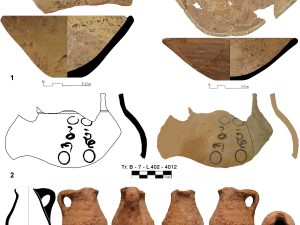
Fig. 5. 1-2. Ostraca with Middle Persian texts. 3. The complete ceramic jar (photo: A. Hasanpour)
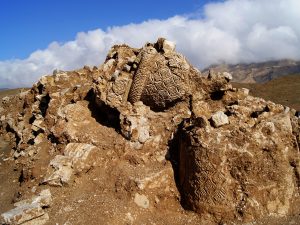
Fig. 6. Fallen stucco decorated columns excavated in 2012 (photo: A. Hasanpour)
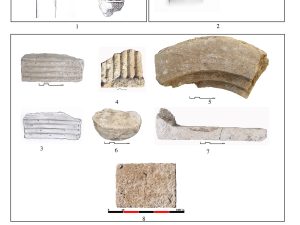
Fig. 7. Fragments of appliques that once decorated upper part of the columns (photo: A. Hasanpour)
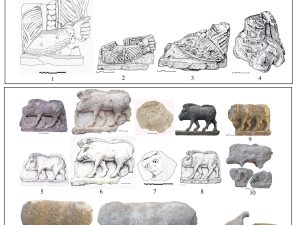
Fig. 8. Stucco fragments depicting human, animal, and vegetal or geometric motifs (photo: A. Hasanpour)
Bibliography
Abdi, K. and A. Lashgari, Gozaresh-e kavosh-e fasl-e nokhost-e mohavate-ye Barz Qawāleh, Ramāvand, unpublished report, ICAR, 1389/2010.
Azarnoush, M., “Hajiabad and the Dialogue of Civilization,” in Ancient Greece and Ancient Iran: Cross Cultural Encounters. 1st International Conference, Athens, 11–13 November 2006, S. M. Darbandi and A. Zurnatzi (eds.), Athens 2008, pp. 41-52.
Borujeni, S. R., Gozāresh-e Barresi va shenāsā’i howze-ye abgir-e sadd-e Seymareh, unpublished report, ICAR, 1386/2007.
Kröger, J., Sasanidischer Stuckdekor, Mainz, 1982.
Kröger, J., “Décor en stuc,” Splendeurs des Sassanides. L’empire perse entre Rome et la Chine (224-642), exhibition catalogue, Musées royaux d’art et d’histoire, Brussels, 1993, pp. 63-65.
Hasanpour, A., Gozāresh-e fasl-e nakhost-e kāvosh-e nejātbakhi-ye Qalā Gūri, Ramāvand, unpublished report, ICAR, 1389/2010.
Hasanpour, A., Gozāresh-e fasl-e dovom-e kāvosh-e nejātbakhi-ye Qalā Gūri, Ramāvand, unpublished report, ICAR, 1391/2012.
Hasanpour, A. and M. Sadeghi Rad, Gozāresh-e fasl-e sevom-e kāvosh-e nejātbakhi-ye Qalā Gūri, Ramāvand, unpublished report, ICAR, 1393/2014.
Hasanpour, A. and Z. Hashemi, “A Comparative Study of the New Sassanid’s Stuccos from Qela Gowri, Ramavand, Lorestan, Iran,” Proceedings of the 9th International Congress on the Archaeology of the Ancient Near East, 9-13 June 2014, Basel, 2014, pp. 1479-1490.


